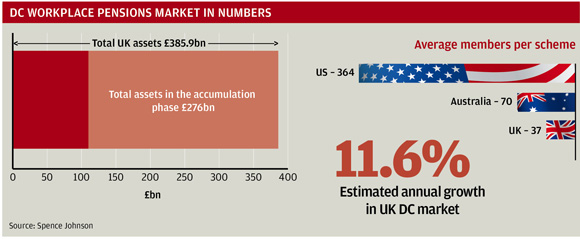This edition of our quarterly feature asks DC experts what they would like to see come out of the focus on quality standards, the effect of mastertrusts on the market and getting value through scale.

What would you like to come out of the government’s call for quality standards in DC pension schemes, and why would it help managers?
Alan Morahan: People generally want certainty on what is expected of them and this will be true of collective bodies, such as trustees. There is now increasing awareness that defined contribution schemes, or DC sections of defined benefit schemes, need to get a higher level of attention, but those responsible for these schemes don’t always know what they should be measuring or against what benchmark. Clear quality standards will give trustees and managers something to aim at.
Stephen Bowles: We would like to see a consistent governance framework for all DC schemes to ensure decisions are taken within a pre-agreed framework and set of objectives. This is essential to ensure the membership profile is taken into account and the scheme does not resort to knee-jerk reactions when faced with a decision. The presence of a proper governance framework will ensure members’ needs drive the decisions and not vice versa. All too often we have seen a herd mentality in DC – particularly in relation to investment defaults. A robust governance framework should ensure schemes do not always go for the easy option.
Richard Wilson: It is essential the government focuses on making sure DC schemes have robust and independent governance that acts in the members’ interests. This is an essential step towards ensuring great default fund investments, and charges that are good value. Auto-enrolment is boosting membership of DC schemes, but governance is essential because these new members are really disengaged and need someone to look out for their interests in the long term.
Paul Bucksey: The government has a really good opportunity to set out a clear framework against which sponsors and trustees can manage their DC schemes. This should include maximum charges, default investment option, governance structure, and at-retirement options. Having done that, I would then like to see it made easier and faster to make changes to contract-based plans.
It’s about expert judgment of value and establishing what the members should have, not necessarily what they want
Roger Mattingly: Probably unsurprisingly, DC schemes are not homogeneous in their quality standards. What needs to come out of the government’s call for quality standards is the introduction of some tangible consistency of best practice. It is not necessarily about certainty of member outcomes or imposed limits on charges, it’s about expert judgment of value and establishing what the members should have, not necessarily what they want.
Tim Banks: In making decisions there should be clearly documented roles and responsibilities, and those making decisions should have the necessary competence and capabilities to discharge their duties. Furthermore it is important that there is clear accountability for the decisions made. Finally, if the market adopts and can demonstrate good governance, why do we need a price cap?
Is the growing dominance of mastertrusts good for the market? Is the regulator right to urge poorly run smaller schemes to consider swapping to a mastertrust or group personal pension?
Bowles: Mastertrusts can offer a solution for smaller DC schemes that want to benefit from bulk purchasing power and economies of scale. However, there are some issues around conflicts of interest, investment and charges that need to be addressed to ensure these are robust long-term solutions. Achieving competitive charges will be more difficult for smaller schemes if they move to a GPP as they do not bring economies of scale. GPPs should not been seen as a light-touch governance option as we do not agree with the view governance should be undertaken at provider level.
Mattingly: The more mastertrusts available, the greater the spread of financial clout and therefore potential dilution of the envisaged benefits of volume. But if the market becomes dominated by a small number of mastertrusts, any economies of scale may well be diluted by the provider advantage of market dominance. Well-designed and well-governed mastertrusts do have a very important part to play in the mass AE compliance requirements, but it is wrong to categorise all smaller schemes as poorly run schemes.
Large mastertrusts should be able to drive down costs while allowing for more sophisticated investment strategies
Banks: More choice for employers and advisers in selecting workplace pension vehicles is a positive innovation. Mastertrusts are usually sold on the basis of high-quality governance, alongside the benefit design features. It is important that the mastertrust is aligned with the interests of the members and has sufficient scale to be commercially sound for the long term.
Bucksey: While many employers and trustees do a very good job of governing their DC schemes, some, particularly at the smaller end, do not. In addition, employers are not currently compelled to govern their contract-based DC plans, which can mean that affected members are suffering high charges, poor administration and less-than-appropriate investment management. Mastertrusts have an in-built and sometimes independent governance structure that may be attractive to corporate DC sponsors lacking the time, resource and/or knowledge to focus on member retirement outcomes.
Morahan: I don’t think it can ever be good for a market if one supplier or product totally dominates. However, through their scale mastertrusts do have an opportunity to redefine the service offering. Large mastertrusts should also be able to drive down costs while allowing for more sophisticated investment strategies. Smaller schemes will have to ask whether they can match the quality standards required by the Pensions Regulator.
Wilson: Mastertrusts allow employees to benefit from trust-based governance without employers having to run their own trusts. The regulator is right to encourage smaller schemes to think about whether they have the resources and expertise to really deliver for their members and should consider moving into a bigger scheme. However, employers should only use a GPP or other contract-based scheme if they are willing to supply the governance and oversight themselves.

How can DC schemes use their growing size to get value for their members?
Banks: Leveraging scale is important in providing value for money for members. The provision of a default investment strategy is a great way of collectively buying fund expertise to bring the overall charge down. It should be remembered there are many ways to get access to scale buying power, and there is a choice on how to spend the benefits of scale, either through reducing costs or improving the quality of the solution for members.
Wilson: The growing size of DC schemes is a huge opportunity to get better value and increase the quality of pensions offered. Schemes should use their increased buying power to keep charges down and to get access to the best investment strategies. Bigger schemes should also find expert advice more affordable – and be able to help their members access good annuity deals.
Bucksey: Value for members may be understood as charges but can also mean additional services. A well-governed DC scheme will typically want to keep pace with general market developments, to understand whether additional services or features could be made available to their members. As a scheme grows, investment fees should be reviewed.
Morahan: It should be incumbent on any trustee or adviser to review the terms and service offering attached to their scheme based around growing assets or membership. Importantly, the focus should not only be on cost. A saving of a few basis points that results in an inferior service will not be appreciated by members. They do know when they are getting a bad service and will voice their concerns. Key performance indicators should be agreed with all parties involved in the scheme and then vigorously monitored to ensure they are being met.
A saving of a few basis points that results in an inferior service will not be appreciated by members
Bowles: Unfortunately larger does generally mean better for most – but not all – DC schemes. Larger schemes are more attractive for providers and therefore more likely to benefit from lower charges. They also tend to have more resources that can be put towards governance. Larger assets can allow access to bespoke investment solutions that may better match the scheme’s objectives. The challenge for the DC industry is to extend these benefits to smaller schemes in a cost-effective and accessible manner so that small schemes do not remain disadvantaged.
Mattingly: Financial clout should be to the advantage of members because of the lower service and management costs, and the availability of greater and more efficient investment choices. It should also mean these expanded DC schemes attract the highest-quality advice and investment management capability, which should all be to the advantage of members. There is however a potential tension between obtaining top-quality advice and the downward pressures on charges.
Does the industry need more adequate benchmarks for a typical DC member’s investment journey in a lifestyle/lifecycle/target date fund?
Bucksey: Default strategies across schemes and providers will be different. However, it is certainly possible to look at aspects of a default strategy, for example average charges, volatility, whether the investment building blocks are actively or passively managed and the level of diversification. It should also be possible to assess the governance framework, for example who has designed the strategy, who is providing the ongoing assessment as to how the strategy is doing and how often the strategy is under the microscope.
Morahan: DB schemes have a clear objective to deliver a certain percentage of a member’s salary at retirement. DC schemes are not usually set this objective and therefore no one knows what they’re aiming at. Meaningful, achievable benchmarks, which can then be referenced in regular member communications, would start to give members confidence that these questions are being answered.
We do not feel this is the most pressing investment issue facing DC schemes
Mattingly: There is currently no universally accepted benchmark for good member outcomes and without this it is challenging to establish benchmarks along the accumulation journey. The real challenge is understandable pension and investment communication along the way. Trustees do however need to be able to monitor default fund effectiveness throughout a member’s lifecycle.
Banks: Benchmarks need to take account of both risk and return on an age-adjusted basis. In this respect it is very easy to see the performance data for the various cohorts of members in a series of target date funds; the trustees or plan sponsors actually experience the member’s investment journey, rather than referring to a series of hypothetical returns.
Bowles: We do not feel this is the most pressing investment issue facing DC schemes. More focus should be given to the different stages of a member’s path to retirement, whether that be the early accumulation, stable growth or derisking phases, and appropriate building blocks for each stage should be used taking into account the level of risk the members are exposed to.
Wilson: The majority of those auto-enrolled will invest in the default fund, so getting schemes’ investment strategies right has never been more important. There is no one-size-fits-all solution – though a derisking phase for members approaching retirement is increasingly commonplace. But it is important that schemes have good governance of the default fund, making changes when necessary.














